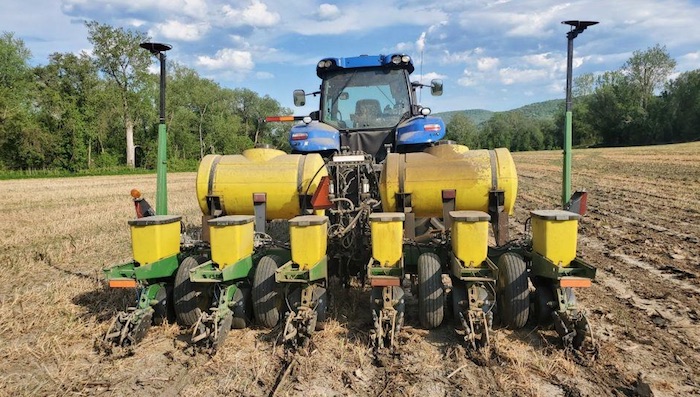This article is by Lou Varricchio, editor of The Sun. It is republished here with permission.
When it comes to increased phosphorus in Lake Champlain, Vermont’s dairy farmers have been the focus of much attention. But they aren’t the only “contributors” linked to changes in the lake.
There may be plenty of “blame” to go around, but finger-pointing rarely solves Vermont’s environmental problems. Serious problems with municipal wastewater breaches, from communities as far away as Rutland, and even sewage from lakeside camps and full-time residence, are all there, too.
The recent “State of the Lake Report,” published by the Lake Champlain Basin Program, shows many areas of lake water improvement but it also acknowledges more work remains to clean up the lake.
Heavy use of manure on local farms is one of the culprits linked to increased phosphorus in the lake.

A manure injection toolbar is used to inject manure below the soil surface and reduce runoff from farm fields at Bridgeman View Farm east of Lake Champlain.
According to the non-profit California-based Sustainable Conservation, “The traditional way of applying manure to crops as fertilizer results in significant air pollution and greenhouse gas emissions, as well as strong odors. The manure slurry is applied to the surface of the field, then left to dry for several days, after which a tractor passes through and incorporates the manure nutrients into the soil. During the drying process, manure nutrients are lost to the atmosphere as ammonium and volatile organic compounds (VOCs) pollute the air, exacerbating serious air pollution… In addition, methane (a potent greenhouse gas) is released from decomposing manure.”
As a result, more local farmers are seeing the light and adopting manure injection as a sustainable way to fertilize their fields.
The benefits of manure injection include reduced air emissions, lower greenhouse gas emissions (and odors), increased use of manure nutrients for improved soil and plant health, more crop acreage accessible for manure application, reduced commercial fertilizer use (saving farmers money), plus a reduced risk of polluting local waterways or groundwater.
Vermont dairy farmer Tim Magnant, of Bridgeman View Farm, is well known in farming circles for espousing the use of manure injection.
“The last two years have been dry so I haven’t had to use any fertilizer on my corn…,” he said. “It also reduces the odor next to the village which I am sure they appreciate… Life is a lot easier (for me)… I don’t have to deal with the (field) stones.”
Last week, the Vermont Agency of Agriculture, Food & Markets (VAAFM) began releasing a new round of funding, through the Capital Equipment Assistance Program (CEAP), for phosphorus removal equipment or technology (manure injection), and for general conservation equipment to be used on farms.
VAAFM officials said Sept. 9 that CEAP is available for equipment that will aid in the reduction of surface runoff of agricultural wastes to state waters. More use of this equipment will improve local water quality, reduce suffocating odors from manure application, separate phosphorus from manure, decrease greenhouse gas emissions, and reduce costs to farmers using an approved Nutrient Management Plan.
There are two separate funding pools available, each with a separate application process and deadline:
Phosphorus Removal: Applications due Oct. 1, 2021
General Conservation Equipment: Applications due Nov. 1, 2021
To apply visit agriculture.vermont.gov/ceap.
All questions regarding this opportunity must be submitted in writing, via email, to AGR.WaterQuality@Vermont.gov, by 4:30 p.m., Sept. 15 and responses will be posted to the program website by 4:30 p.m. on Sept. 22.


